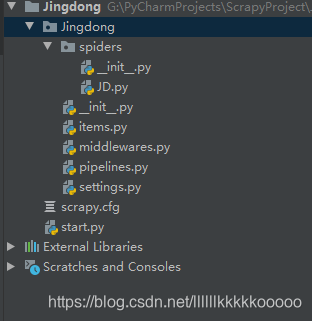一、项目准备
创建scrapy京东项目
scrapy startproject Jingdong
cd Jingdong
scrapy genspider JD
修改和添加基本配置
- 创建start.py启动py文件

from scrapy import cmdline
cmdline.execute("scrapy crawl JD".split())
- 配置settings




二、网页及代码分析
网页分析
进入京东


分析网页请求,根据一下规律可进行多页请求

数据位置找寻

图片url

图片价格

图片标题

代码分析
JD.py
# -*- coding: utf-8 -*-
import scrapy
from Jingdong.items import JingdongItem
import time
class JdSpider(scrapy.Spider):
name = 'JD'
allowed_domains = ['jingdong.com']
start_urls = ['https://search.jd.com/Search?keyword=%E6%89%8B%E6%9C%BA&wq=%E6%89%8B%E6%9C%BA&page=1&s=1&click=0']
#定义num和s,其实为page和s,通过修改用来进行多页爬取
num = 1
s = 1
def parse(self, response):
time.sleep(0.5)
#使用xpath语法找寻数据位置,可参考上图
ul_list = response.xpath("//ul[@class='gl-warp clearfix']/li")
for ul in ul_list:
img_url = "http:" + ul.xpath(".//img/@src").get()
price = ul.xpath(".//i/text()").get()
title = ul.xpath(".//div[@class='p-name p-name-type-2']//em/text()").get()
item = JingdongItem(img_url=img_url,title=title,price=price)
yield item
self.s += 50
self.num += 2
#注意要将s和num转化为string字符串再进行拼接
next_url = "https://search.jd.com/Search?keyword=%E6%89%8B%E6%9C%BA&wq=%E6%89%8B%E6%9C%BA&page=" + str(self.num) + "&s=" + str(self.s) + "&click=0"
#我们这里只爬取四页
if self.num <= 7:
print(next_url)
print(self.num)
#设置dont_filter=True不过滤重复网页,不设置的话只能爬取一页
yield scrapy.Request(url=next_url,callback=self.parse,encoding="utf-8",dont_filter=True)
pipelines.py

数据库建表语句
CREATE TABLE `jingdong` (
`id` int(11) NOT NULL AUTO_INCREMENT,
`img_url` varchar(255) DEFAULT NULL,
`title` varchar(255) DEFAULT NULL,
`price` decimal(10,2) DEFAULT NULL,
PRIMARY KEY (`id`)
) ENGINE=InnoDB AUTO_INCREMENT=121 DEFAULT CHARSET=utf8mb4 COLLATE=utf8mb4_0900_ai_ci;
分析
# -*- coding: utf-8 -*-
# Define your item pipelines here
#
# Don't forget to add your pipeline to the ITEM_PIPELINES setting
# See: https://docs.scrapy.org/en/latest/topics/item-pipeline.html
from scrapy.pipelines.images import ImagesPipeline
import scrapy
import pymysql
#下载商品图片
class JingdongDownloadPipeline(ImagesPipeline):
num = 0
def get_media_requests(self, item, info):
img_url = item['img_url']
img_name = item['title']
#传递img_name对图片进行重命名
yield scrapy.Request(url=img_url,meta={"name":img_name},dont_filter=True)
def file_path(self, request, response=None, info=None):
name = request.meta["name"]
self.num += 1
#把图片名称中的\t和\n都替换掉
img_name = str(name).replace("\t","").replace("\n","")
#在图片名称最后拼上数字式使每张图片名称都不同(这是经过博主测试得到的)
return img_name + str(self.num) + ".jpg"
#保存商品数据到Mysql
class JingdongPipeline(object):
def __init__(self):
dbparams = {
'host': '127.0.0.1',
'port': 3306,
'user': 'mysql账号',
'password': 'mysql密码',
'database': 'jingdong', #数据库名称
'charset': 'utf8'
}
self.conn = pymysql.connect(**dbparams) #构建连接
self.cursor = self.conn.cursor() #创建一个游标
self._sql = None
def process_item(self,item,spider):
#执行sql语句
self.cursor.execute(self.sql, (item['img_url'], item['title'], item['price']))
self.conn.commit() #事务提交
return item
#使用@property装饰器来创建只读属性,@property装饰器会将方法转换为相同名称的只读属性,可以与所定义的属性配合使用,这样可以防止属性被修改。
@property
def sql(self):
if not self._sql:
self._sql = """
insert into jingdong(id,img_url,title,price)
values(null ,%s,%s,%s)
"""
return self._sql
return self._sql
运行结果


三、完整代码
JD.py
# -*- coding: utf-8 -*-
import scrapy
from Jingdong.items import JingdongItem
import time
class JdSpider(scrapy.Spider):
name = 'JD'
allowed_domains = ['jingdong.com']
start_urls = ['https://search.jd.com/Search?keyword=%E6%89%8B%E6%9C%BA&wq=%E6%89%8B%E6%9C%BA&page=1&s=1&click=0']
num = 1
s = 1
def parse(self, response):
time.sleep(0.5)
ul_list = response.xpath("//ul[@class='gl-warp clearfix']/li")
for ul in ul_list:
img_url = "http:" + ul.xpath(".//img/@src").get()
price = ul.xpath(".//i/text()").get()
title = ul.xpath(".//div[@class='p-name p-name-type-2']//em/text()").get()
item = JingdongItem(img_url=img_url,title=title,price=price)
yield item
self.s += 50
self.num += 2
next_url = "https://search.jd.com/Search?keyword=%E6%89%8B%E6%9C%BA&wq=%E6%89%8B%E6%9C%BA&page=" + str(self.num) + "&s=" + str(self.s) + "&click=0"
if self.num <= 7:
print(next_url)
print(self.num)
yield scrapy.Request(url=next_url,callback=self.parse,encoding="utf-8",dont_filter=True)
pipelines.py
# -*- coding: utf-8 -*-
# Define your item pipelines here
#
# Don't forget to add your pipeline to the ITEM_PIPELINES setting
# See: https://docs.scrapy.org/en/latest/topics/item-pipeline.html
from scrapy.pipelines.images import ImagesPipeline
import scrapy
import pymysql
class JingdongDownloadPipeline(ImagesPipeline):
num = 0
def get_media_requests(self, item, info):
img_url = item['img_url']
img_name = item['title']
yield scrapy.Request(url=img_url,meta={"name":img_name},dont_filter=True)
def file_path(self, request, response=None, info=None):
name = request.meta["name"]
self.num += 1
img_name = str(name).replace("\t","").replace("\n","")
return img_name + str(self.num) + ".jpg"
class JingdongPipeline(object):
def __init__(self):
dbparams = {
'host': '127.0.0.1',
'port': 3306,
'user': 'root',
'password': 'wad07244058664',
'database': 'Jingdong',
'charset': 'utf8'
}
self.conn = pymysql.connect(**dbparams)
self.cursor = self.conn.cursor()
self._sql = None
def process_item(self,item,spider):
self.cursor.execute(self.sql, (item['img_url'], item['title'], item['price']))
self.conn.commit()
return item
@property
def sql(self):
if not self._sql:
self._sql = """
insert into jingdong(id,img_url,title,price)
values(null ,%s,%s,%s)
"""
return self._sql
return self._sql
settings.py
# -*- coding: utf-8 -*-
# Scrapy settings for Jingdong project
#
# For simplicity, this file contains only settings considered important or
# commonly used. You can find more settings consulting the documentation:
#
# https://docs.scrapy.org/en/latest/topics/settings.html
# https://docs.scrapy.org/en/latest/topics/downloader-middleware.html
# https://docs.scrapy.org/en/latest/topics/spider-middleware.html
BOT_NAME = 'Jingdong'
SPIDER_MODULES = ['Jingdong.spiders']
NEWSPIDER_MODULE = 'Jingdong.spiders'
LOG_LEVEL = "ERROR"
# Crawl responsibly by identifying yourself (and your website) on the user-agent
#USER_AGENT = 'Jingdong (+http://www.yourdomain.com)'
# Obey robots.txt rules
ROBOTSTXT_OBEY = False
# Configure maximum concurrent requests performed by Scrapy (default: 16)
#CONCURRENT_REQUESTS = 32
# Configure a delay for requests for the same website (default: 0)
# See https://docs.scrapy.org/en/latest/topics/settings.html#download-delay
# See also autothrottle settings and docs
#DOWNLOAD_DELAY = 3
# The download delay setting will honor only one of:
#CONCURRENT_REQUESTS_PER_DOMAIN = 16
#CONCURRENT_REQUESTS_PER_IP = 16
# Disable cookies (enabled by default)
#COOKIES_ENABLED = False
# Disable Telnet Console (enabled by default)
#TELNETCONSOLE_ENABLED = False
# Override the default request headers:
DEFAULT_REQUEST_HEADERS = {
'Accept': 'text/html,application/xhtml+xml,application/xml;q=0.9,*/*;q=0.8',
'Accept-Language': 'en',
'user-agent': 'Mozilla/5.0 (Windows NT 10.0; Win64; x64) AppleWebKit/537.36 (KHTML, like Gecko) Chrome/83.0.4103.116 Safari/537.36'
}
# Enable or disable spider middlewares
# See https://docs.scrapy.org/en/latest/topics/spider-middleware.html
#SPIDER_MIDDLEWARES = {
# 'Jingdong.middlewares.JingdongSpiderMiddleware': 543,
#}
# Enable or disable downloader middlewares
# See https://docs.scrapy.org/en/latest/topics/downloader-middleware.html
# DOWNLOADER_MIDDLEWARES = {
# 'Jingdong.middlewares.JingdongDown': 543,
# }
# Enable or disable extensions
# See https://docs.scrapy.org/en/latest/topics/extensions.html
#EXTENSIONS = {
# 'scrapy.extensions.telnet.TelnetConsole': None,
#}
# Configure item pipelines
# See https://docs.scrapy.org/en/latest/topics/item-pipeline.html
ITEM_PIPELINES = {
'Jingdong.pipelines.JingdongDownloadPipeline': 1,
# 'Jingdong.pipelines.JingdongPipeline': 300,
}
# Enable and configure the AutoThrottle extension (disabled by default)
# See https://docs.scrapy.org/en/latest/topics/autothrottle.html
#AUTOTHROTTLE_ENABLED = True
# The initial download delay
#AUTOTHROTTLE_START_DELAY = 5
# The maximum download delay to be set in case of high latencies
#AUTOTHROTTLE_MAX_DELAY = 60
# The average number of requests Scrapy should be sending in parallel to
# each remote server
#AUTOTHROTTLE_TARGET_CONCURRENCY = 1.0
# Enable showing throttling stats for every response received:
#AUTOTHROTTLE_DEBUG = False
# Enable and configure HTTP caching (disabled by default)
# See https://docs.scrapy.org/en/latest/topics/downloader-middleware.html#httpcache-middleware-settings
#HTTPCACHE_ENABLED = True
#HTTPCACHE_EXPIRATION_SECS = 0
#HTTPCACHE_DIR = 'httpcache'
#HTTPCACHE_IGNORE_HTTP_CODES = []
#HTTPCACHE_STORAGE = 'scrapy.extensions.httpcache.FilesystemCacheStorage'
import os
IMAGES_STORE = "Download"
items.py
# -*- coding: utf-8 -*-
# Define here the models for your scraped items
#
# See documentation in:
# https://docs.scrapy.org/en/latest/topics/items.html
import scrapy
class JingdongItem(scrapy.Item):
img_url = scrapy.Field()
price = scrapy.Field()
title = scrapy.Field()
到这也算结束了,觉得博主写的不错的可以点赞收藏关注哦,谢谢各位!
本次爬取京东虽然完成,但还是有些美中不足,那就是京东的每页有60条数据,默认加载30条数据,还有30数据需要向下滑动滚轮才会继续加载,这就需要使用到Selenium操纵滚轮进行滑动,但本次博主没有使用,有强迫症的读者大大可以看我的下一篇文章。